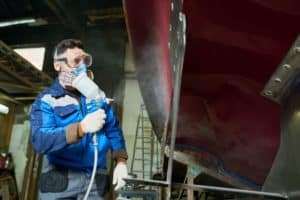Whether you’re out for an afternoon of leisure with family in the marina, or you’re in the great open ocean and ready to head back after a long day, no one wants to turn the ignition key to be met with nothing but a churning noise, or even worse, nothing at all! Here are some quick troubleshooting ideas you can check for in case your boat engine won’t start, so you can get back out on the waves!
Common problems to keep an eye out for
Safety Lanyard
Most, if not all boats, are connected to a safety lanyard, which is also known as the kill cord, and it’s one of the most crucial safety features on a seafaring vessel. Its basic function is to stop the motor in case the helmsman, who would attach it to their wrist or jacket, falls or goes overboard. In the event the person is thrown from their seat, the cord is pulled, the boat stops, and the person can easily return to the helm.
When this cord isn’t connected, the engine will not crank, plain and simple. The easiest fix for this is to check down and see if the cord has been accidentally disconnected, and if so, just reconnect it! You might be in luck, and find yourself underway in no time.
Dead Boat Battery
If you can notice that the starter is engaging, but the engine is slow to turn, your battery might be starting to run low. If it doesn’t turn over at all, however, it’s probably dead. If you have a voltmeter handy, check to make sure that your battery is registering at 12.6V for a full charge. If your battery isn’t charging, or won’t hold a charge at all, it’s most likely time to replace it.
If your boat has multiple batteries, or a battery switch, make sure to set your switch to the right position. These systems are usually set in place to save your battery power, however they can prevent the boat from running if you don’t remember to turn them back on before your outing
Gear in Neutral
If you’ve gone through the previous scenario and reconnected your safety lanyard, you might find yourself wondering why you’re still dead in the water. This could be due to an extremely easy-to-forget safety feature after the lanyard has been disconnected: most boats have an automatic stop that doesn’t allow the engine to operate when left in gear. If you find this is the case, shift the boat back into neutral, turn it off, and turn it back on.
Fuel Problems
There are a couple of different gas problems that can plague boats, so make sure to check any one or more of these options to rule them out.
Not enough gas
It may sound obvious enough, but even if you’re absolutely certain that you filled up before you left dock, however, it’s never a bad idea to have extra fuel onboard in case.
The air vent wasn’t left open
In order for your engine to get fuel and run properly, the gas tank needs to have the air vent left open to prevent a vacuum from forming and pressure from building up in the tank. If your air vent is accidentally left closed, you won’t be able to get an adequate amount of fuel to your engine. Check it out when trying to diagnose the problem.
Fuel lines are in proper working order
Just like your garden hose at home, if your fuel lines going from your fuel tank to your engine are bent or kinked, you’ll have problems with the flow. If you suspect that your fuel line is the problem, follow the line from the fuel tank down to the engine and make sure nothing is placed on it, and it’s not stuck between the tank and deck.
Engine Not Primed
If you’ve tried everything else, but the engine hasn’t been primed, you could be still wondering what’s going wrong. Depending upon the engine and primer you have on your boat, you can generally have two different priming systems. If you have an older boat, most likely you will have to manually prime the boat by turning the key to the “on” position and waiting while the engine powers up. If your engine doesn’t start after allowing it to prime, check to make sure the priming system is in working order, and the fuel is getting to the engine.
If you have an electric primer, check that fuel is properly reaching the engine by disconnecting a fuel line that goes from the primer to the carburetor or the engine intake. Make sure to have a bucket on hand, and have someone else press the primer switch to see if any fuel makes it out of the line.
Corleone Marinas Knows Boat Maintenance and Repair
Still trying to work out the problem? No problem.
Corleone Marinas has four stunning locations in Elizabeth Bay, Balmain, Drummoyne, and Hawkesbury River at Long Island, all of which are managed by some of the best in the industry. Each location offers a full range of marina services, including wet berths, moorings, slipways for boats up to sixty feet with shipwrights and mechanics on hand.
Contact us today to learn more.






